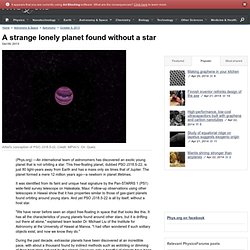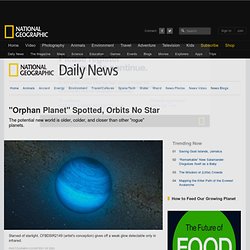

Hubble Immortalizes Itself With New Image: “Fountain of Youth” To commemorate the Hubble Space Telescope’s 19 years in space, the ESA and NASA have released an image of a celestial celebration.

Two members in this trio of galaxies are apparently engaged in a gravitational tug-o-war, giving rise to a bright streamer of newborn blue stars that stretches 100,000 light years across. Constellation region near ARP 194. Credit: NASA, ESA Z. Levay and A. Fujii. Malala Yousafzai gets her own asteroid - BBC Newsbeat.
She's the teenage activist who campaigned for girls' education in Pakistan, and was shot by the Taliban.

She's also a Nobel Prize winner, and now Malala Yousafzai has had an asteroid named after her. Online Sky Map - Stelvision Astronomy. A Cosmic Map of the Exoplanets [Interactive] Exoplanet hunters have been busy.
![A Cosmic Map of the Exoplanets [Interactive]](http://cdn.pearltrees.com/s/pic/th/exoplanets-interactive-75710636)
Since 2011 astronomers have discovered, on average, about three exoplanets every week—a precious few of which lie in the “habitable zone,” where water could take liquid form. This chart maps the known cosmic neighborhood of 861 planets. Click on the options under "Select layout" to map the planets based on their location in the sky, or on their distance from the Sun. Dawn Mission: Dawn - Home Page. Cosmoquest. Astronomy Photographer of the Year : Exhibitions : What's on. Take home the best of Astronomy Photographer of the Year The Royal Observatory has partnered with Collins to produce a beautiful hardback book featuring all the winning and shortlisted images from the 2013 Astronomy Photographer of the Year competition.

Order yours now from our shop. Astronomy Photographer of the Year Award Winners: Photos. So It Ends for Comet ISON - Comets. Well, don't say we didn't warn you.

As we hoped all along wouldn't happen, Comet ISON turned into a dud not a dazzle — a speck not a spectacle — a complete, unmitigated flop in terms of any kind of visual display for the world in the December dawn sky. But it sure was exciting while it lasted, and never more so than on November 27th and 28th as it approached and then passed through perihelion while spacecraft watched. Our web traffic spiked through the roof as we posted the ever-changing news to our ISON Updates page. Real-time science is incredibly thrilling in the internet age. Especially when a scientific team as dedicated as the Comet ISON Observing Campaign makes so much effort to keep the world abreast of developments as they happen.
To recap: Comet ISON thwarted predictions at every turn. Then, as it disappeared down into the glare of sunrise for viewers on Earth, spacecraft took over. Scientists glumly pronounced near-obituaries on a live NASA webcast. Oh well. P. Ison_anim.gif. Comet ISON Model. Chunks of Ice May Have Broken Off Comet ISON. Although Comet ISON appears to be holding its own against the increasing solar heat as it continues its risky game of “chicken” with the sun, the large mass of ice isn’t getting away unscathed — new observations show evidence for one or more large icy chunks breaking away from ISON’s nucleus.

Comet ISON: 5 Things You Should Know Earlier this month, the potential “Comet of the Century” underwent a rapid brightening event, likely caused large fissures of ice suddenly sublimating and blasting gas into space. The resulting increase of gas contained within the comet’s coma and tail reflected more light from the sun, causing it to brighten and become a naked-eye object. Although ISON could be spotted for a few days just before dawn, its light is quickly becoming overwhelmed by sunlight as it approaches perihelion (solar close approach). Astronomy: Planets in our galaxy may be vastly more numerous than believed - latimes.com.
The Milky Way galaxy may be filled with millions upon millions of Jupiter-sized planets that have escaped their solar systems and are wandering freely in space, researchers said Wednesday in a finding that seems certain to make astronomers rethink their ideas about planetary formation.

Scientists had previously thought that about 20% of stars had massive planets attached to them, but the new results reported in the journal Nature suggest that there are at least twice as many planets as stars, and perhaps several times as many. The finding "is a revelation in the sense that it looks like a quintupling of the number of gas giants in the universe," said astronomer Alan Boss of the Carnegie Institution for Science, who was not involved in the research. "Nomad" Planets More Common Than Thought, May Orbit Black Holes. Stars and even black holes likely harbor "rogue," or "nomad," planets that were kicked out of the star systems where they were born, new simulations suggest. At the same time, a separate study suggests nomad planets are much more common than thought.
Astronomers used to shrug off notions of rogue planets, also called free-floating planets. Yet in the past few years, indirect observations of these galactic wanderers—combined with detailed supercomputer simulations—have suggested they do exist. A study released Thursday, for instance, hints rogue planets might outnumber the Milky Way's 200 to 400 billion stars by a mind-boggling 100,000 to 1. A strange lonely planet found without a star. (Phys.org) —An international team of astronomers has discovered an exotic young planet that is not orbiting a star.

This free-floating planet, dubbed PSO J318.5-22, is just 80 light-years away from Earth and has a mass only six times that of Jupiter. The planet formed a mere 12 million years ago—a newborn in planet lifetimes. [1310.0457] The Extremely Red, Young L Dwarf PSO J318-22: A Free-Floating Planetary-Mass Analog to Directly Imaged Young Gas-Giant Planets. "Orphan Planet" Spotted, Orbits No Star.
A search for would-be stars called brown dwarfs has yielded something even more elusive: a potential orphan planet.

Some four to seven times the mass of Jupiter, the wandering planet orbits no star, a team of French and Canadian astronomers reported this week. Scientists believe such objects—also called homeless, free-floating, or rogue planets—can form in one of two ways. Either they're ejected from star systems, or they form independently. CFBDSIR2149-0403: a 4–7 Jupiter-mass free-floating planet in the young moving group AB Doradus? Earth-Size "Lone Wolf" Planets May Host Life. Maybe some Earth-size planets were just born to be wild.

Across the galaxy, countless "rogue" Earths may have been ejected from their planetary neighborhoods and are now zipping alone through space, previous studies have suggested. Searching for New Earths. It took humans thousands of years to explore our own planet and centuries to comprehend our neighboring planets, but nowadays new worlds are being discovered every week. To date, astronomers have identified more than 370 “exoplanets,” worlds orbiting stars other than the sun. Many are so strange as to confirm the biologist J. Astronomers Get First Peek at Atmosphere of a "Super-Earth" Exoplanet. Someday in the coming years, if astronomers finally succeed in locating a virtual Earth twin outside the solar system—a tiny dot of a world at a temperate, life-enabling distance from a sunlike star—the achievement will hardly be cause for resting on observational laurels.
Instead another race will begin: to characterize the planet and its atmosphere and to determine if the world is truly habitable or, tantalizingly, if it is already inhabited by some extraterrestrial life-form. Exoplanet near Gliese 581 star 'could host life' 17 May 2011Last updated at 11:22 Kirsty Lang explains the unique qualities of the exoplanet Gliese 581d A red dwarf star 20 light-years away is again providing hints that it hosts the first definitively habitable planet outside our Solar System. The planet Gliese 581d is at the colder outer edge of the "Goldilocks zone" in which liquid water can be sustained. Meteorite Collision - \\\\\ Ursi's Blog ////// [en] Comet Lemmon. Comet's water 'like that of Earth's oceans' 6 October 2011Last updated at 01:45 By Jason Palmer Science and technology reporter, BBC News Comet Hartley 2 was also the subject of the Deep Impact probe study Comet Hartley 2 contains water more like that found on Earth than all the comets we know about, researchers say.
A study using the Herschel space telescope aimed to measure the fraction of deuterium, a rare type of hydrogen, present in the comet's water. Like our oceans, it had half the amount of deuterium seen from other comets. The result, published in Nature, hints at the idea that much of the Earth's water could have initially come from cometary impacts. Just a few million years after its formation, the early Earth was rocky and dry; most likely, something brought the water that covers most of the planet today. Asteroids, by contrast, give rise to the meteors and meteorites that arrive on Earth, making their deuterium fraction more well-established.
Near Earth Objects: AKA Asteroids. Asteroid Mining - Most Valuable and Profitable Asteroids Ranking - Asterank. 2012 DA14 Rotating. Brown dwarf. Infrared image showing two brown dwarfs in the binary system CFBDSIR 1458+10, obtained using the Laser Guide Star (LGS) Adaptive Optics system on the Keck II Telescope in Hawaii. Brown dwarfs are substellar objects too low in mass to sustain hydrogen-1 fusion reactions in their cores, unlike main-sequence stars, which can.
They occupy the mass range between the heaviest gas giants and the lightest stars, with an upper limit around 75[1] to 80 Jupiter masses (MJ). Brown dwarfs heavier than about 13 MJ are thought to fuse deuterium and those above ~65 MJ, fuse lithium as well.[2] 'Brown dwarf' has chance to shine after new telescope sees beyond brighter companion. By Julian Gavaghan Updated: 13:14 GMT, 25 March 2011. Stars and Galaxies. Rosette nebula. 3D structure of supernovae revealed. In a new study, researchers used the Faint Object Camera and Spectrograph (FOCAS) on the Subaru Telescope to conduct observations that revealed a clumpy 3D structure of supernovae. This finding by a research group led by Dr. Masaomi Tanaka (National Astronomical Observatory of Japan), Dr. Koji Kawabata (Hiroshima University), Dr. Takashi Hattori (National Astronomical Observatory of Japan), and Dr. JPL. Max-Planck-Institut für Astronomie.
A blog about science being done with Pan-STARRS1.